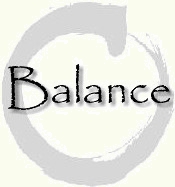good vibrations
Musical Massage
The power of music is well known. We can be soothed by the soft easy rythm of a lullaby or stimulated by a more uptempo tune.
To enhance your massage experience at Balance there are a number of musical selections available including cd's designed to help with meditation, better sleep, and healthier lifestyles.
List of available cd's coming soon!
You may also bring in your own music selections and self-help cd's.
Clinical studies and anecdotal evidence from music therapists suggest that the sound of music:
- manages pain
- improves mood and mobility of people with Parkinson's disease
- reduces the need for sedatives and pain relievers during and after surgery
- decreases nausea during chemotherapy
- helps patients participate in medical treatment that shortens hospital stays
- relieves anxiety
- lowers blood pressure
- eases depression
- enhances concentration and creativity
Rythm
All life consists of rhythmic processes. From the simple pulsations of a single-cell organism to the rising and falling of our breath, life is filled with rhythm.
Entrainment
Entrainment is an aspect of sound that is closely related to rhythms and the way these rhythms affect us. It is defined as the synchronization of two or more rhythmic cycles. This phenomenon of nature has to do with the conservation of energy. It seems that nature finds it more economical in terms of energy to have periodic events that are close enough in frequency to occur in phase or in step with each other.
Within our own bodies, we are constantly locking in our own rhythms. Our heart rate, respiration and brain waves all entrain to each other. Slow down your breath, for example, and you slow down your heartbeat and your brain waves. Conversely, if you are able to slow down your brain waves, you can affect your heart rate and respiration. This is one of the principles of biofeedback.
As the functions of the human body can entrain to each other, it is possible to use external rhythms to affect the internal mechanism of heart rate, respiration and brain wave activity.
Brain Waves
Our brain waves pulsate and oscillate at particular frequencies that can be measured, just like sound waves, in cycles per second. There are four basic delineations of different brain wave states, based upon the cycles per second of the brain. They are:
Beta waves-from 14 to 20 hz. They are found in our normal waking state of consciousness. Beta waves are present when our focus of attention is on activities of the external world.
Alpha waves-from 8 to 13 hz. They occur when we daydream and are often associated with a state of meditation. Alpha waves become stronger and more regular when our eyes are closed.
Theta waves-from 4 to 7 hz. They are found in states of high creativity and have been equated to states of consciousness found in much shamanic work. Theta waves also occur in state of deep meditation and sleep.
Delta waves-from .5 to 3 hz. They occur in states of deep sleep or unconsciousness. Some of the newer brain wave work indicates that a state of deep meditation produces Delta waves in conscious individuals.
Two other delineations of brain-wave activity have been noted by some researches:
High Beta-from 23 to 33 hz. They are associated with hyperactivity and some types of anxiety.
K Complex-over 33 hz. They usually occur in short bursts and are often associated with the "aha" moments, when there is a sudden integration of ideas or experiences.
